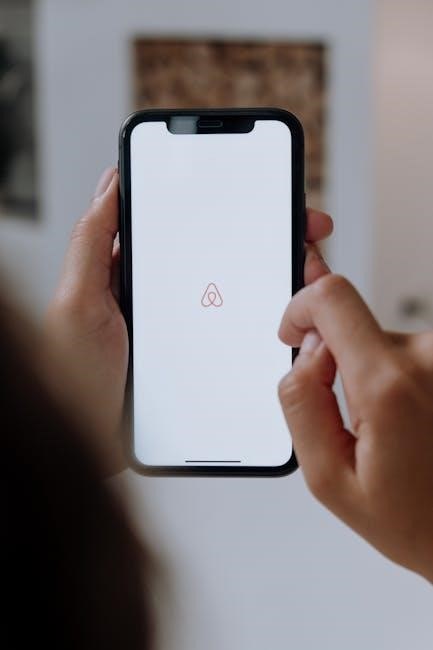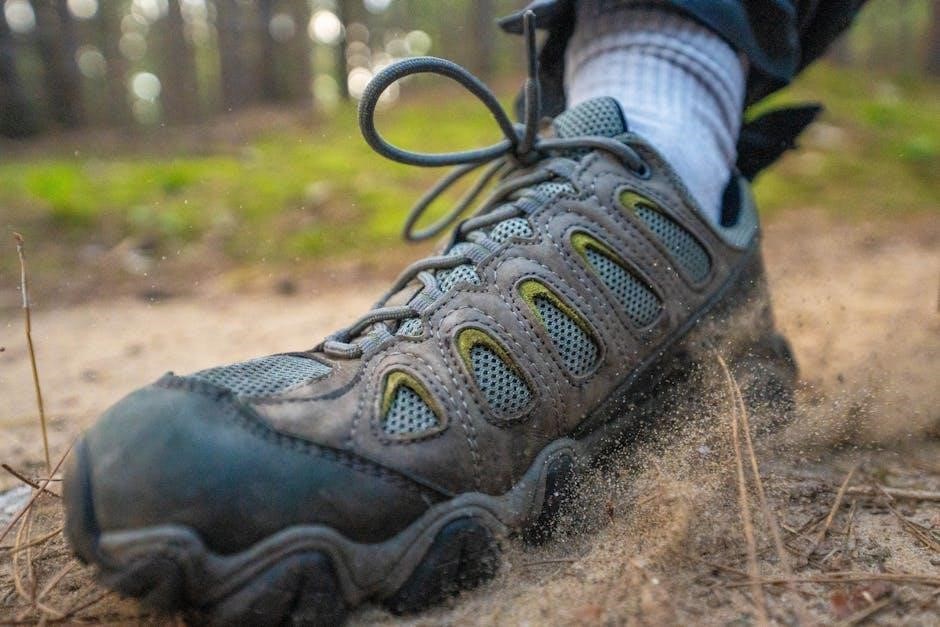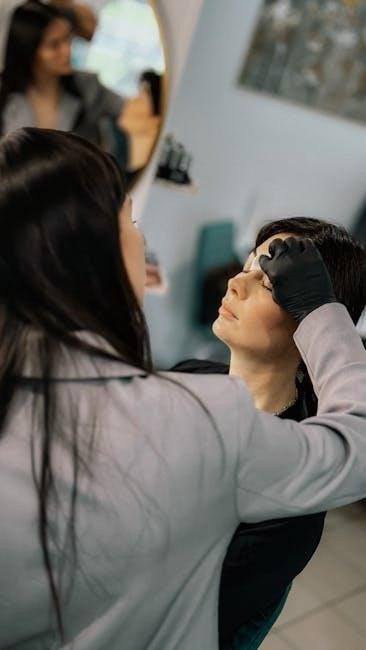
The Unna Boot is a specialized inelastic bandage used in compression therapy‚ primarily for treating venous leg ulcers‚ edema‚ and wound care. It combines zinc oxide paste for antibacterial properties‚ providing static compression to promote healing and protect the wound site. Widely used in medical settings‚ it is a critical component in wound management‚ offering effective support and protection to facilitate recovery.
What is an Unna Boot?
The Unna Boot‚ also known as a paste boot‚ is a specialized inelastic bandage used in compression therapy. It combines a zinc oxide paste with gauze‚ providing static compression to treat venous leg ulcers‚ edema‚ and burns. Applied from the toes to the knee‚ it promotes wound healing by reducing swelling and protecting the wound site. Its antibacterial and anti-inflammatory properties create a moist environment conducive to healing‚ making it an essential tool in wound care for promoting tissue repair and preventing infection.
History and Development of Unna Boot
The Unna Boot was developed by German dermatologist Carl Paul Unna in the early 20th century. Initially used for treating burns and skin ulcers‚ it evolved into a critical tool for venous leg ulcer management. Unna’s innovation of combining zinc oxide paste with gauze created a unique compressive dressing. Over time‚ its design and application techniques were refined‚ making it a standard in wound care. Today‚ it remains a cornerstone of compression therapy‚ widely recognized for its effectiveness in promoting healing and managing edema.
Key Features and Benefits of Unna Boot
The Unna Boot offers static compression‚ crucial for reducing edema and promoting blood flow. Its unique blend of zinc oxide paste provides antibacterial and anti-inflammatory properties‚ fostering a healing environment. The boot’s multi-layered gauze wrapping ensures even pressure distribution‚ while its occlusive nature retains moisture‚ keeping the wound bed hydrated. These features make it an effective solution for venous ulcers‚ burns‚ and post-surgical wounds‚ enhancing patient comfort and accelerating recovery. Its durability and ease of application further solidify its role in modern wound care.

Application Process of Unna Boot
The Unna Boot is applied by wrapping multiple layers of gauze from the toes to the knee‚ using a figure-eight pattern for even compression and support.
Step-by-Step Guide to Applying an Unna Boot
1. Clean and dry the leg‚ applying topical dressings to wounds.
2. Flex the patient’s foot to 90 degrees to prevent bunching.
3. Apply zinc oxide paste evenly to the leg.
4. Wrap the boot from toes to knee using a figure-eight pattern.
5. Secure the boot with tape‚ ensuring snug‚ even compression.
This method ensures optimal compression‚ promoting healing and reducing swelling.
Preparation for Unna Boot Application
Preparation is essential for effective Unna Boot application. Begin by washing and drying the leg thoroughly. Apply an antibiotic cream or antiseptic to the wound to prevent infection. Ensure the area is clean and dry before proceeding. The patient should be comfortable‚ with their foot flexed to 90 degrees to avoid bunching. Gather all necessary materials‚ including the Unna Boot‚ zinc oxide paste‚ and medical tape. Proper preparation ensures a clean‚ dry environment‚ promoting successful application and wound healing. Attention to detail is critical for optimal results.
Wrapping Techniques for Optimal Compression
Wrapping techniques for the Unna Boot are crucial for achieving optimal compression. The bandage is applied in a figure-eight pattern‚ starting at the base of the toes and extending to the knee. This ensures even pressure distribution and prevents bunching. The boot is wrapped in multiple layers‚ with the first layer applied moist to adhere to the skin. Subsequent layers provide additional compression and support. Proper tension is essential to avoid constriction while maintaining therapeutic pressure. The boot should never stop mid-calf‚ ensuring full coverage and effectiveness in reducing edema and promoting blood flow.
Securing the Boot for Maximum Effectiveness
To ensure the Unna Boot remains effective‚ it must be secured properly. After applying the layers‚ an Ace wrap is often used to provide additional compression and hold the bandage in place. This helps maintain consistent pressure and prevents the boot from shifting. The Ace wrap should be snug but not overly tight to avoid discomfort or restrict circulation. Regular checks are essential to ensure the boot remains securely fastened‚ and adjustments can be made as needed to maintain optimal compression and comfort for the patient.

Benefits of Using Unna Boot
The Unna Boot promotes wound healing‚ reduces edema‚ and protects the wound site. Its static compression enhances blood flow‚ while zinc oxide provides antibacterial benefits‚ ensuring comfort and faster recovery.
Promoting Wound Healing
The Unna Boot fosters a moist environment‚ essential for tissue repair. Its static compression reduces swelling‚ improving blood flow to the affected area. The zinc oxide in the boot has antibacterial properties‚ minimizing infection risks and inflammation. This creates an optimal setting for granulation and epithelialization‚ key stages in wound healing. Regular use can accelerate recovery‚ especially in venous ulcers‚ by maintaining a clean‚ protected wound bed. Proper application ensures these benefits are maximized‚ aiding in faster and more effective healing outcomes for patients.
Reducing Edema and Swelling
The Unna Boot effectively reduces edema and swelling through its static compression properties. By applying consistent pressure‚ it prevents fluid accumulation in the affected limb. This compression enhances venous return‚ alleviating swelling and discomfort. The boot’s inelastic design ensures graduated compression‚ which is particularly beneficial for patients with chronic venous insufficiency. Regular use helps redistribute fluid‚ reducing the risk of complications like ulceration. This makes the Unna Boot a highly effective tool for managing edema and promoting a healthier circulation system.
Protecting the Wound Site
The Unna Boot provides exceptional protection for the wound site by creating a barrier against bacteria and external irritants. Its multi-layered design ensures the wound remains moist‚ promoting tissue repair while preventing infection. The boot’s zinc oxide paste offers antibacterial properties‚ further safeguarding the wound. By retaining moisture and shielding the area from physical injury‚ the Unna Boot fosters an ideal environment for healing. This protective feature is essential for preventing complications and ensuring the wound progresses toward recovery without interference.
Enhancing Blood Flow
The Unna Boot enhances blood flow through its static compression‚ which helps reduce edema and improve circulation. By applying consistent pressure‚ the boot promotes venous return‚ reducing swelling and enhancing oxygen delivery to tissues. Improved blood flow accelerates wound healing‚ supports tissue repair‚ and strengthens the leg’s overall vascular health. This mechanism is particularly beneficial for patients with venous insufficiency‚ as it aids in restoring normal blood flow patterns and preventing further complications. Enhanced circulation fosters a healthier environment for recovery and tissue regeneration.

Challenges and Troubleshooting
Common challenges include boot loosening or tightness‚ causing discomfort or compromising effectiveness. Proper training and monitoring are essential to address these issues and prevent complications during use.
Common Issues During Application
Common issues during Unna Boot application include improper wrapping techniques‚ leading to uneven compression or restricted movement. Patients may experience discomfort due to tightness or loosening of the boot over time. Ensuring the boot is applied correctly‚ with even pressure and proper alignment‚ is crucial to avoid complications. Proper training and adherence to application guidelines help mitigate these issues‚ ensuring optimal comfort and effectiveness for the patient.
Addressing Patient Discomfort
Patient discomfort during Unna Boot application can arise from tightness‚ loosening‚ or improper wrapping. To address this‚ ensure the boot is applied with even pressure‚ avoiding excessive tightness that restricts movement. Proper fitting and alignment are crucial to prevent discomfort. Using the correct materials‚ such as zinc oxide paste‚ helps reduce irritation. Healthcare professionals should guide patients on positioning and monitor for signs of discomfort. Regular follow-ups and adjustments can help maintain patient comfort while ensuring the boot remains effective in promoting healing and managing edema.
Dealing with Boot Loosening or Tightness
To address boot loosening or tightness‚ ensure proper fit during application. If the boot feels too tight‚ gently adjust the wrapping‚ focusing on even pressure distribution. For loosening‚ re-wrap or tighten the layers without compromising circulation. Regular monitoring is essential to prevent complications. Patients should be instructed to report any discomfort or restricted movement immediately. Proper adjustment techniques and daily checks can help maintain optimal compression and comfort‚ ensuring the boot remains effective in promoting healing and managing edema or swelling.

Coding and Documentation
Accurate coding and documentation are essential for Medicare billing and reimbursement. Ensure proper procedure codes and detailed records of each Unna Boot application for compliance.
Medicare Billing for Unna Boot Application
Medicare billing for Unna Boot applications requires accurate coding and documentation. Providers must use specific procedure codes for compression therapy and wound care services. A detailed documentation checklist ensures compliance with Medicare guidelines‚ including verification of medical necessity. Proper coding helps in timely reimbursement and avoids claim denials. Always consult Medicare policies for updates and specific billing requirements. Accurate documentation of each application‚ including patient assessment and treatment details‚ is essential for successful claims submission.
Documentation Best Practices
Accurate and detailed documentation is crucial for Unna Boot applications. Maintain clear records of each application‚ including the patient’s medical history‚ wound assessment‚ and treatment plan. Document the materials used‚ the technique applied‚ and any patient-specific instructions provided. Ensure compliance with clinical guidelines and coding requirements. Regularly update records to reflect progress‚ changes in treatment‚ or any adverse reactions. Proper documentation supports continuity of care‚ facilitates reimbursement‚ and ensures accountability in wound management. Always follow institutional protocols for documenting Unna Boot applications.
Importance of Accurate Coding
Accurate coding is essential for proper billing and documentation of Unna Boot applications. It ensures compliance with Medicare guidelines and avoids reimbursement issues. Codes must reflect the procedure‚ materials used‚ and patient-specific conditions. Precise coding helps track treatment efficacy and patient outcomes. Inaccurate coding can lead to delayed payments or compliance issues. Always use updated coding standards and consult official guidelines for Unna Boot applications. Correct coding ensures seamless administrative processes and maintains the integrity of medical records. It is a critical step in managing wound care effectively.

Home Care Instructions
Keep the Unna Boot dry and clean‚ using a plastic bag to cover it while showering. Monitor for loosening or saturation and seek medical attention if issues arise. Follow dietary advice and stay hydrated to promote healing. Regularly inspect the boot and replace it as directed by healthcare professionals to ensure proper wound care and prevent complications.
How to Care for an Unna Boot at Home
To care for an Unna Boot at home‚ keep it dry and clean. Use a plastic bag to cover it while showering‚ and secure it with an Ace wrap. Monitor the boot daily for signs of loosening‚ saturation‚ or irritation. If any issues arise‚ seek medical attention promptly. Follow your healthcare provider’s instructions for replacement‚ typically every 3 to 7 days‚ depending on wound condition and drainage. Elevate your leg to reduce swelling and avoid tight clothing that may restrict circulation. Regular follow-ups with your healthcare provider are essential to ensure proper healing and address any concerns.
Monitoring for Signs of Complications
Monitor the Unna Boot daily for signs of complications‚ such as increased redness‚ swelling‚ or warmth around the wound. Watch for drainage‚ odor‚ or pus‚ which may indicate infection. Check the boot’s fit; it should not be too tight or too loose‚ as this can impair circulation. If you notice numbness‚ tingling‚ or pain‚ contact your healthcare provider immediately. Addressing these issues promptly helps prevent serious complications and ensures proper healing. Regular monitoring is crucial for maintaining the effectiveness of the Unna Boot and overall wound care.
When to Seek Medical Attention
Seek immediate medical attention if you notice increased pain‚ swelling‚ redness‚ or warmth around the wound. If you experience numbness‚ tingling‚ or discoloration‚ contact your healthcare provider. Signs of infection‚ such as foul odor‚ pus‚ or fever‚ require prompt evaluation. If the Unna Boot feels too tight or restricts movement‚ seek medical help to avoid circulation issues. Any unusual drainage or bleeding also warrants attention. Timely intervention ensures proper wound healing and prevents serious complications.

Maintenance and Replacement
The Unna Boot must be checked daily for loosening or saturation. Replace every 3-7 days or as needed. Seek professional guidance for proper removal and reapplication.
How Often to Replace the Boot
The frequency of replacing the Unna Boot depends on factors such as wound type‚ drainage level‚ and patient condition. Typically‚ it is replaced every 3 to 7 days or as needed. If the boot becomes loose‚ saturated‚ or shows signs of compromise‚ it should be replaced immediately. Wounds with heavy drainage may require more frequent changes‚ while those with minimal exudate can last longer. Always follow healthcare provider guidance for replacement to ensure optimal wound healing and prevent complications. Regular monitoring is essential to determine the appropriate replacement schedule.
Proper Removal and Inspection Techniques
Removing the Unna Boot requires care to avoid damaging the boot or irritating the skin. Start by gently unwrapping the outer layers‚ working from the top down. Use scissors to carefully cut the bandage if it adheres to the skin. Once removed‚ inspect the boot and the leg for signs of wear‚ such as loosening or saturation. Check the wound site for healing progress‚ drainage‚ or infection indicators. Document findings for medical records and to guide reapplication. Proper inspection ensures effective wound management and prevents complications.
Reapplying the Boot After Removal
After removing the Unna Boot‚ clean and dry the leg thoroughly. Reassess the wound for healing progress or signs of complications. Reapply a thin layer of zinc oxide paste if needed. Wrap the boot using the same technique as the initial application‚ ensuring even compression and proper alignment. Secure the boot firmly but not too tightly to maintain effectiveness. Monitor the boot for any signs of loosening or saturation and adjust as necessary. Proper reapplication ensures continued wound protection and therapeutic benefits‚ promoting optimal healing outcomes for the patient.

When to Use Unna Boot
The Unna Boot is primarily used for treating venous leg ulcers‚ managing edema‚ and post-burn care. It provides compression and protection‚ aiding in wound healing and recovery.
Treating Venous Leg Ulcers
The Unna Boot is highly effective in treating venous leg ulcers by providing consistent compression‚ which reduces swelling and enhances blood flow. Its zinc oxide paste promotes a healing environment‚ preventing infection and encouraging tissue repair. The boot’s static compression helps close ulcerations faster and reduces the risk of recurrence. It is particularly beneficial for patients with chronic venous insufficiency‚ as it supports the venous return and alleviates discomfort. Regular application of the Unna Boot is a cornerstone in managing venous leg ulcers‚ offering both therapeutic and protective benefits.
Managing Edema
The Unna Boot is an effective solution for managing edema‚ as its static compression reduces swelling and improves blood circulation. The boot’s multiple layers provide graduated compression‚ reducing fluid retention and promoting lymphatic drainage. This helps alleviate discomfort and prevents further swelling. The zinc oxide paste in the boot also protects the skin‚ reducing irritation. Regular use of the Unna Boot is particularly beneficial for patients with chronic edema‚ offering consistent support and promoting faster recovery. It is a non-invasive‚ reliable method for edema management‚ enhancing patient comfort and mobility.
Post-Burn Care
The Unna Boot is a valuable tool in post-burn care‚ providing protection and promoting healing for burn injuries. Its zinc oxide paste offers antibacterial and anti-inflammatory properties‚ reducing the risk of infection and inflammation. The boot creates a moist environment that fosters healing while shielding the wound from bacteria and contaminants. It is often applied in layers‚ typically 3 to 4‚ using a figure-eight wrapping technique to ensure even pressure distribution. Regular replacement‚ usually every 3 to 7 days‚ is essential to monitor healing progress and prevent complications. Home care instructions emphasize keeping the boot dry and using protective measures during showers. This method is particularly effective for promoting tissue repair and minimizing scarring in post-burn patients.

Obtaining the Unna Boot Application Guide
The Unna Boot Application Guide is readily available in PDF format‚ providing step-by-step instructions for healthcare professionals and patients to ensure proper application and optimal wound healing outcomes.
Downloading the PDF Guide
The Unna Boot Application PDF guide is easily accessible online‚ providing a comprehensive resource for proper application techniques. It offers step-by-step instructions‚ materials needed‚ and expert tips to ensure effective use. The guide is designed for both healthcare professionals and patients‚ making it a valuable tool for wound care. By downloading the PDF‚ users gain access to detailed protocols‚ troubleshooting advice‚ and best practices for optimal outcomes. This convenient format allows for quick reference‚ ensuring the Unna Boot is applied correctly and safely every time.
Using the Guide for Training
The Unna Boot Application PDF guide serves as an excellent training tool for healthcare professionals and students. It provides clear‚ illustrated instructions and step-by-step protocols‚ making it ideal for hands-on training sessions. The guide covers essential topics like preparation‚ wrapping techniques‚ and troubleshooting‚ ensuring comprehensive understanding. By using the guide‚ trainees can master the correct application methods‚ improve patient outcomes‚ and adhere to clinical standards. Regular review of the guide helps reinforce best practices and maintains proficiency in Unna Boot application.
Key Sections of the Guide
The Unna Boot Application PDF guide includes essential sections such as step-by-step instructions‚ preparation tips‚ and post-application care. It details wrapping techniques‚ compression methods‚ and troubleshooting common issues. The guide also covers monitoring for complications and provides clear visuals for better understanding. Additional sections focus on patient education‚ home care instructions‚ and maintenance protocols. These key areas ensure comprehensive guidance for both healthcare professionals and patients‚ promoting effective and safe Unna Boot use.

Best Practices for Unna Boot Use
Ensure proper fit‚ use correct materials‚ and follow clinical protocols for optimal results. Regular monitoring and patient education are crucial for effective and safe Unna Boot use.
Ensuring Proper Fit
Proper fit is crucial for the effectiveness of an Unna Boot. The boot should be snug but not overly tight‚ allowing for even compression without restricting movement. It is essential to ensure the boot extends from the base of the toes to just below the knee‚ avoiding mid-calf termination. The figure-eight wrapping technique helps distribute pressure evenly‚ preventing hotspots. Patients should be able to wiggle their toes comfortably‚ indicating adequate fit. Improper fit can lead to discomfort or reduced therapeutic benefits‚ emphasizing the need for precise application.
Using the Correct Materials
Using the correct materials is essential for the proper application of an Unna Boot. The boot typically consists of a zinc oxide-impregnated gauze‚ which provides antibacterial and anti-inflammatory properties. Additional layers‚ such as elastic bandages or compression stockings‚ are often applied over the gauze to enhance compression and support. It is crucial to use high-quality‚ sterile materials to minimize the risk of infection and ensure optimal compression. The materials should be applied in the correct sequence‚ as outlined in the Unna Boot application guide‚ to achieve the desired therapeutic benefits.
Following Clinical Protocols
Following clinical protocols is crucial for the effective and safe application of an Unna Boot. This involves adhering to established steps‚ such as wound assessment‚ cleansing‚ and applying zinc oxide paste. The boot must be wrapped in a figure-eight pattern to ensure even compression. Regular inspections and documentation of the boot’s condition are also essential. By following these protocols‚ healthcare professionals can minimize complications and ensure optimal therapeutic outcomes. Proper training and adherence to guidelines are key to successful Unna Boot application‚ as outlined in clinical resources and application guides.